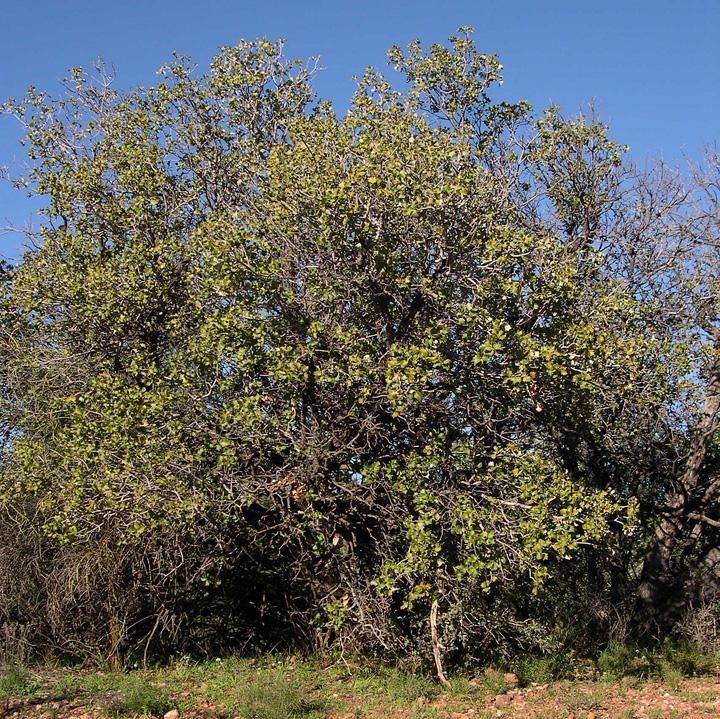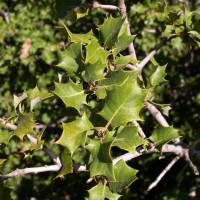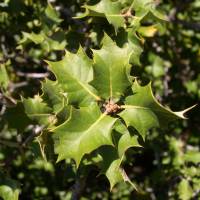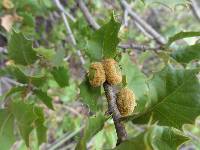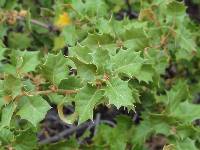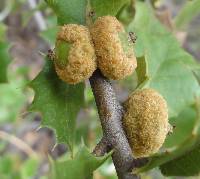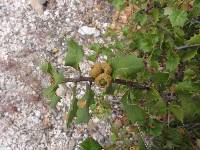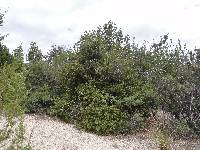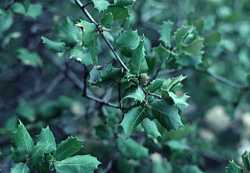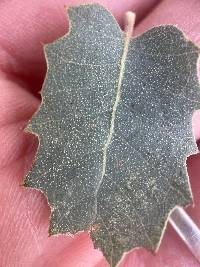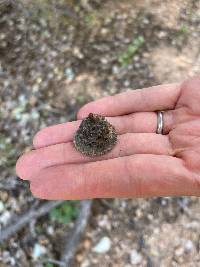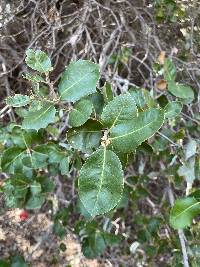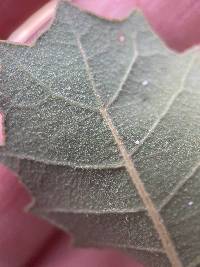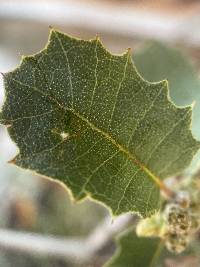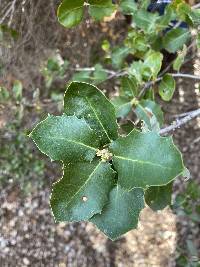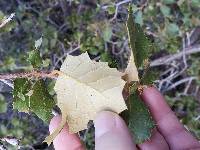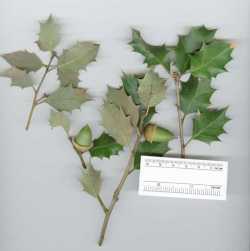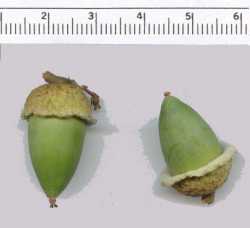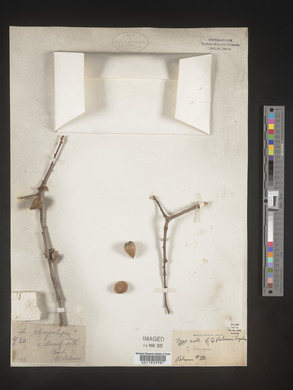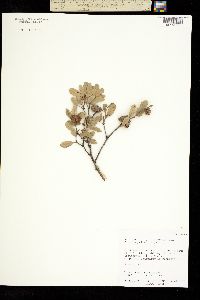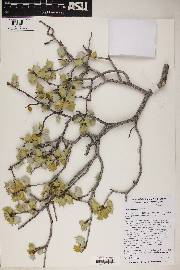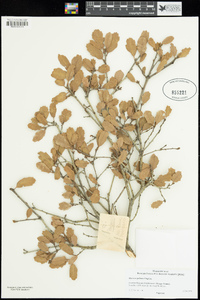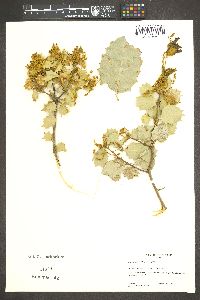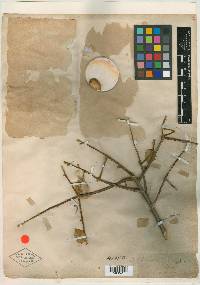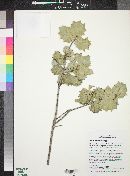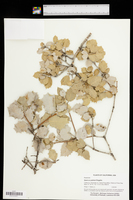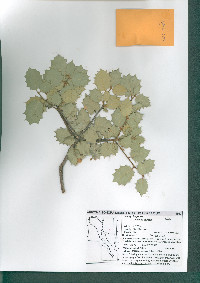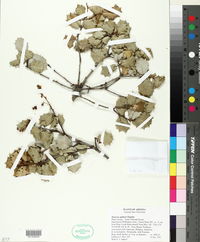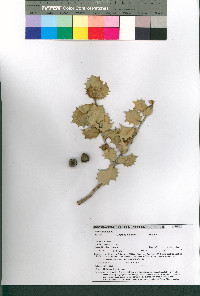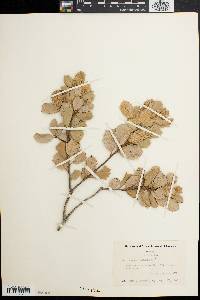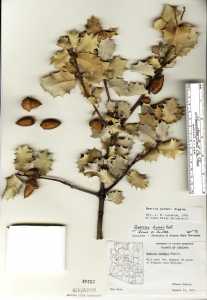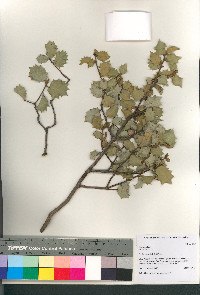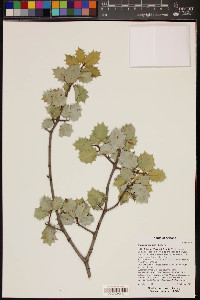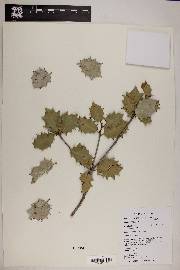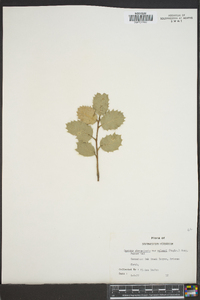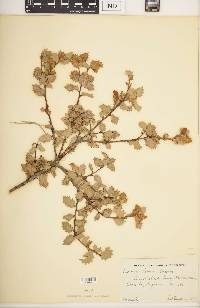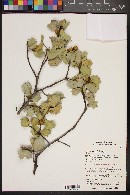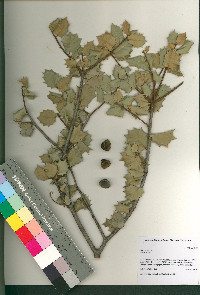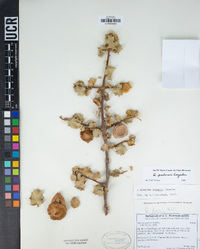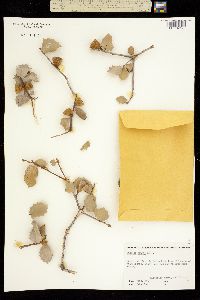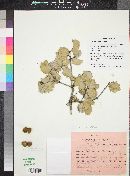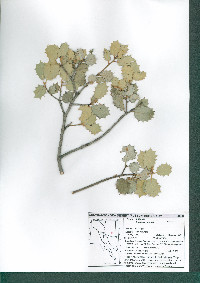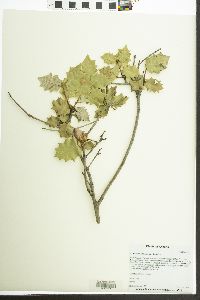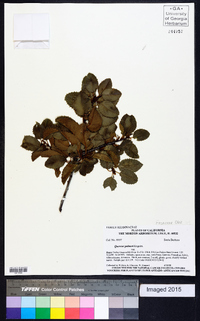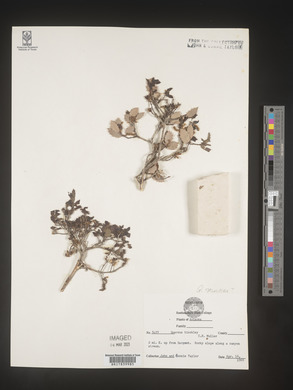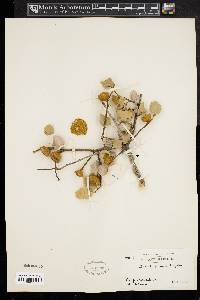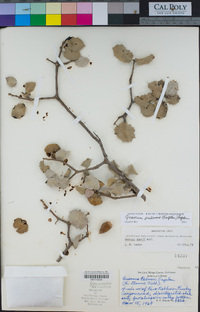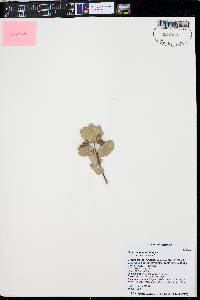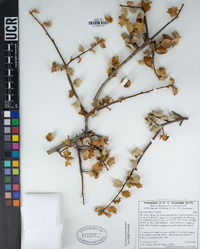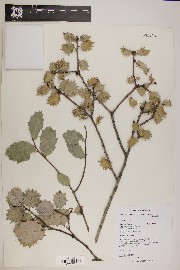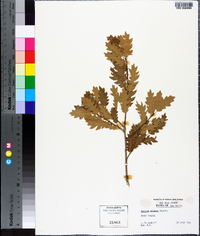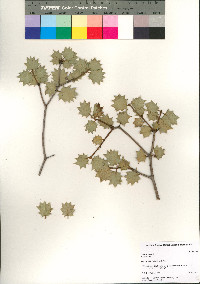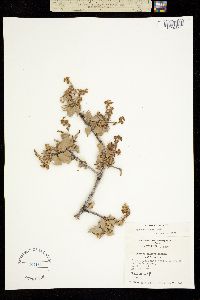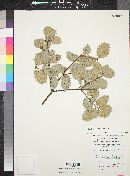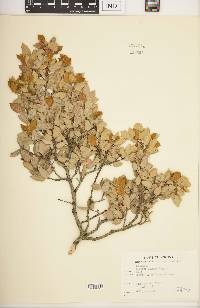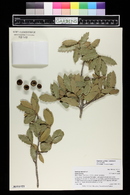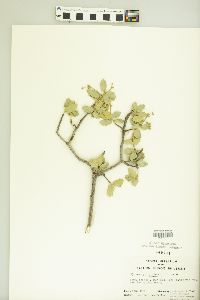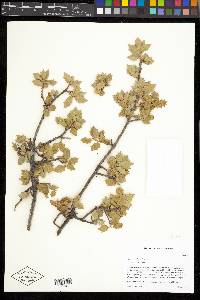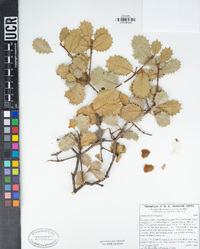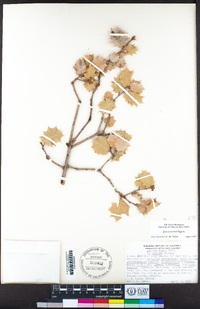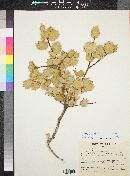
|
|
|
|
Family: Fagaceae
Dunn's Oak, more...Palmer oak, shrub oak, dunn oak (es: encinillo)
[Quercus chrysolepis var. palmeri (Engelm.) Sarg., moreQuercus chrysolepis var. palneri (Engelm.) Sarg., Quercus dunnii Kellogg] |
Small trees and shrubs , to 2-3 m. Twigs rigid, divaricately branched at 65-90° angles, reddish brown, 1.5-3 mm diam., pubescent, sparsely so in 2d year. Terminal buds ovoid, 1-1.5 mm, apex rounded, glabrous. Leaves: petiole 2-5 mm, round in cross section, glabrous to sparsely fasciculate-pubescent. Leaf blade suborbiculate, elliptic to round-ovate, 20-30(-50) × 20-40 mm, crisped, leathery and brittle, base obtuse to strongly subcordate, secondary veins 5-8(-12) pairs, each terminating in spine, basal pairs recurving, others branching at 45° angles, raised abaxially, margins spinose-dentate to occasionally entire, with highly thickened cell walls, spines cartilaginous, (1-)1.5-2 mm, apex broadly rounded or subacute, spinose; surfaces abaxially glaucous with waxy layer, often obscured by golden brown glandular hairs, adaxially grayish dark green, scurfy with fasciculate erect and twisting hairs. Acorns solitary or rarely paired; cup turbinate to saucer-shaped, margins involute, often irregular, 7-10 mm deep × 10-25(-35) mm wide, scales appressed, embedded, often appearing laterally connate into concentric rings with only tip of scale visible, tuberculate, densely golden-tomentose throughout; nut oblong to fusiform, 20-30 × 10-15 mm, apex acute. Flowering in spring. Disjunct in canyons, mountain washes, dry thickets, and margins of chapparal communities; 700-1800 m; Ariz, Calif.; Mexico (n Baja California). Populations of Quercus palmeri are often small and may exist as single clones. The disjunct populations of California and Baja California are consistent morphologically. In Arizona populations, individuals tend to have flatter leaves bearing fewer teeth; this distinction is not constant, however. Morphologically aberrant populations identified as Q . palmeri in eastern Arizona (Chiracahua, Huachuca, and Santa Catalina mountains) and southwestern New Mexico are most likely the result of introgression from Q . palmeri to Q . chrysolepis (J. M. Tucker and H. S. Haskell 1960). Those populations tend to be intermediate in overall morphology, but all lack the diagnostic trichomes and biochemical markers of Q . palmeri ; they are best classified as Q . chrysolepis affinity Q . palmeri .
Plant: shrub, 1-3 m high, the bark dark gray, with many scaly, narrow plates between fissures, the young growth often covered with orangeish glandular hairs; young twigs woolly to sparsely pubescent, the older twigs glabrescent, gray, often blackened, remaining more or less smooth Leaves: unlobed, ovate to suborbicular, 1.5-4.5(-6.5) cm long, 1-4.4 cm wide, 0.9-1.8 times as long as wide, often covered with orangeish glandular hairs at first, later glabrescent, strongly glaucous below, lustrous dark green above, drying light gray-green above, persisting to 3 years; stellate hairs on lower leaf surface essentially none; apex acute to rounded, sharply mucronate; base truncate, subcordate to rounded; petiole 2-5 mm long, pubescent to glabrous; midvein prominent below, nearly flat or raised and faint above; lateral veins prominent below, faint to obscure above, about 3-6(-8) pairs ascending to nearly perpendicular to midvein; secondary veins usually visible below, usually indistinct above; blade stiffly coriaceous, contorted to nearly flat; margin revolute or not, each side armed with about 3-9 sharply spinescent, radiating teeth INFLORESCENCE: staminate flowers in aments; pistillate flowers solitary or in groups on spikes, these sometimes abbreviated, each pistillate flower with a separate involucre Flowers: mostly wind-pollinated, unisexual, the perianth much reduced or absent; staminate flowers in heads or aments, the perianth greenish, the stamens 7-9; pistillate flowers usually tricarpellate, solitary or in clusters of about 3 or more, subtended individually or in groups by an involucre that develops into a woody cupule enclosing or subtending the mature fruit(s) Fruit: ACORNS subconical, 3-3.5 cm long; cap bowl to nearly plate shaped, 1-13 mm long, 15-30 mm wide, covered with orangeish glandular hairs without, densely woolly within, the hairs curly and matted, the margins of the cap usually flared, often irregular; scales on mature cap not clearly overlapping, the base blending in with cap; nut-shell densely woolly within Misc: Chaparral to pinyon-juniper; 750-1800 m (2500-6000 ft); Apr-Jul (fr. Aug-Oct) REFERENCES: Landrum, Leslie R. Fagaceae. 1994. J. Ariz. - Nev. Acad. Sci. Volume 27, 203-214 Landrum 1993 Common Name: Palmer oak Duration: Perennial Nativity: Native Lifeform: Shrub Wetland Status: None General: Shrub 1-3 m high, bark dark gray, with many scaly, narrow plates, narrow plates between fissures, young grown often covered with orangeish glandular hairs; young twigs woolly to sparsely pubescent, the older twigs glabrescent, gray, often blackened, remaining more or less smooth. Leaves: Unlobed, ovate to suborbicular, 1.5-4.5 cm long, 1-4.4 cm wide, 0.9-1.8 times as long as wide, often covered with orangeish glandular hairs at first, later glabrescent, strongly glaucous below, lustrous dark green above; persisting to 3 years; apex acute to rounded, 3-9 sharply spinescent, radiating teeth, base truncate to rounded, on petiole 2-5 mm long; veins prominent below. Flowers: Staminate aments with reduced perianth parts, 4-12 stamens; pistillate flowers solitary or in clusters of 2-3; inferior ovary. Fruits: Subconical acorns, 3-3.5 cm long, cap bowl to nearly plate shaped, 1-13 mm long, 15-30 mm wide, covered with orangeish glandular hairs without, margins of the cap usually flared irregularly. Ecology: Found in the chaparral and pi-on-juniper communities from 2,500-6,000 ft (762-1829 m); flowers April-July. Notes: Distinctive with its wavy ovate leaves and spinescent teeth radiating along the margins. Ethnobotany: Acorns boiled into mush, or dried and used for food. Etymology: Quercus is the classical Latin word for oak, thought to be derived from Celtic quer, fine, and cuez, tree, dunnii is named for George Washington Dunn (1814-1905) who collected in California. Synonyms: Quercus chrysolepis var. palmeri, Quercus palmeri Editor: SBuckley, 2010 |
|
|
|
This project was made possible in part by the Institute of Museum and Library Services [MG-70-19-0057-19].
Powered by Symbiota

